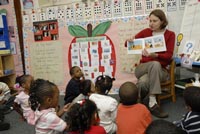Once Upon a Time...
April 21, 2009 - A professor learned how young children respond to picture books.
Asked what a book titled Red Riding Hood might be about, Keyron answers, "Probably she read and she write a lot, and she live in the 'hood."
Penn GSE Professor Larry Sipe is delighted by the triple pun but, since he's been studying young children's literary understanding for the past 12 years, he's not particularly surprised by Keyron's verbal dexterity.
 Sipe is intrigued by what happens when teachers read aloud to their young students — and how kindergartners like Keyron make literary sense of picture books — and he's drawn on his close observations of classroom conversations to develop the first comprehensive theoretical model of children's rich and varied responses to literature.
Sipe is intrigued by what happens when teachers read aloud to their young students — and how kindergartners like Keyron make literary sense of picture books — and he's drawn on his close observations of classroom conversations to develop the first comprehensive theoretical model of children's rich and varied responses to literature.
Based on hours of observation in classroom read-alouds to young children, Sipe has worked out a conceptual framework for understanding how children respond to picture books. In his book, Storytime, he describes five different kinds of responses — analytical, intertextual, personal, transparent, and performative — and how those responses can play on the development of young children's literary understanding.
In taking an analytical stance, children deal with the text as a means for constructing narrative. The focus is on structure, the sequence of illustrations, the relation between text and image, and the traditional elements of narrative like setting, character, plot, etc. By far the most widespread response, the analytical counted for approximately 73 percent of what children had to say about the books being read to them.
Like budding literary critics, though, children may also relate a particular book to other cultural artifacts, noting a resembled to other books, movies, videos, TV shows, the work of their classmates (Sipe's "intertextual" response). They may also find ways to connect the text to their own lives or vice versa in a personal response that either draws on their own experience to understand the text or turns to the text for illumination about something happening to them.
While the intertextual response turns children into young critics, the performative transforms them into improv artists. Here, they use the text as a staging ground for what Sipe calls "a carnivalesque romp," bending the characters and situation to their own imaginative will.
In the most mysterious response of the five — the transparent response — children, in a sense, enter into the world of the story completely — as when a class of kindergartners, hearing about Mr. McGregor's pursuit of Peter Rabbit, shout "Run for your life!"
But Sipe's purposes in the book are larger than simply defining categories of response. Rather, he draws on them to advance a theory of the literary understanding of young children. In Sipe's view, these five categories are the enactments of three basic literary impulses: the hermeneutic, the personalizing, and the aesthetic.
The hermeneutic impulse builds on analytic and intertextual responses to create an understanding of the story and, ultimately, to help children "master the text." The personalizing impulse draws on children's personal response "to use the story to inform (or even transform) one's own life. And the aesthetic impulse, which derives from the performative and transparent responses, satisfies "the desire to ... experience the freedom that art provides." Together, Sipe argues, these impulses interact to create literary understanding.
Storytime concludes with Sipe's reflections on the ways in which teachers can help children interpret picture storybooks and, in the process, develop their literary understanding.
